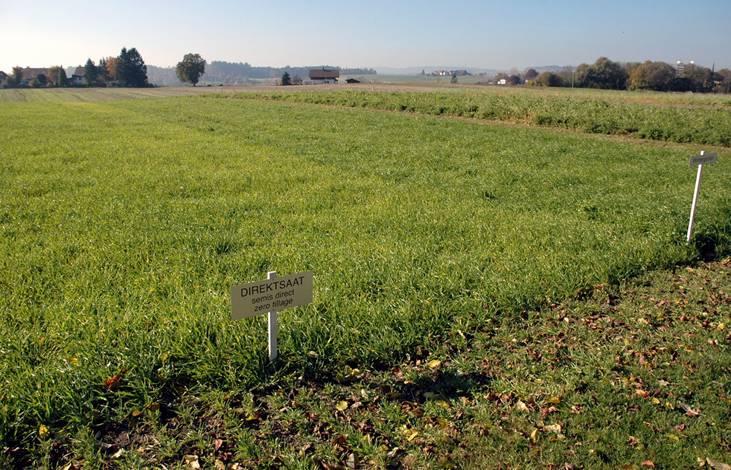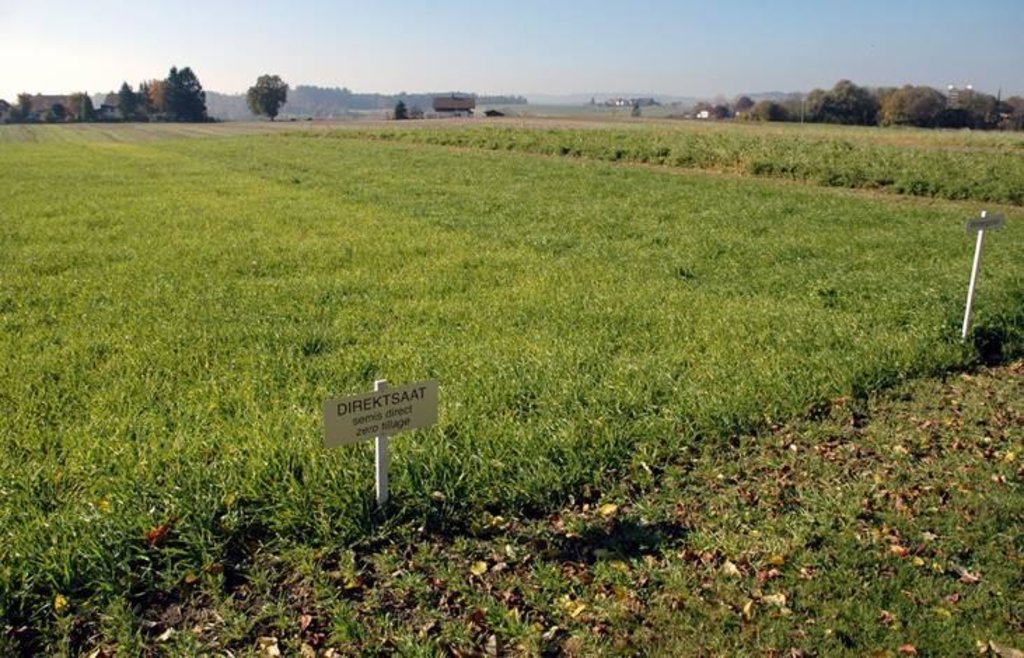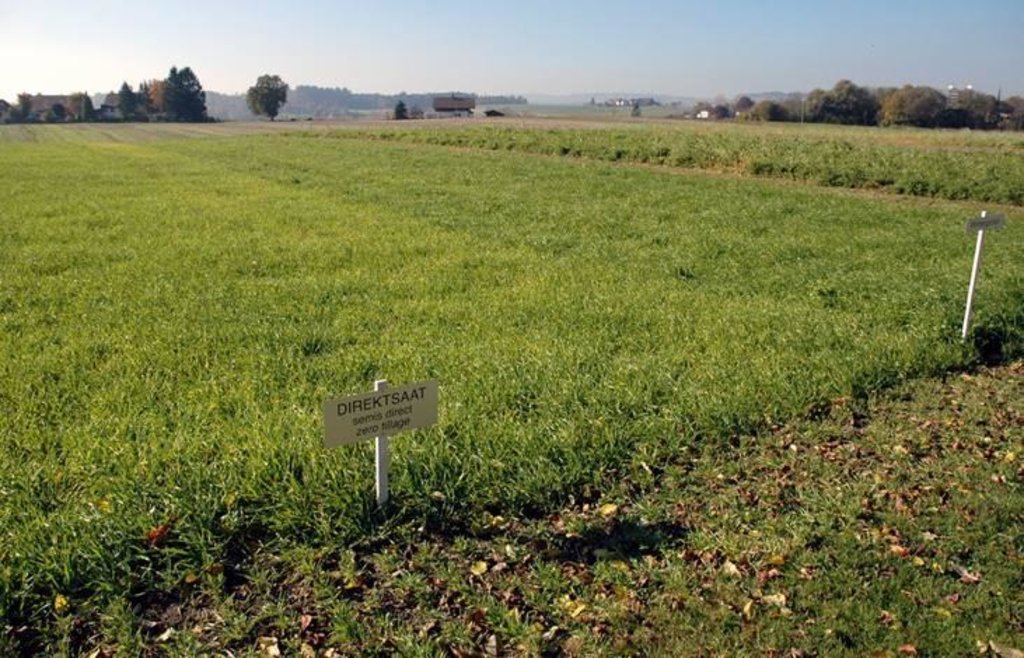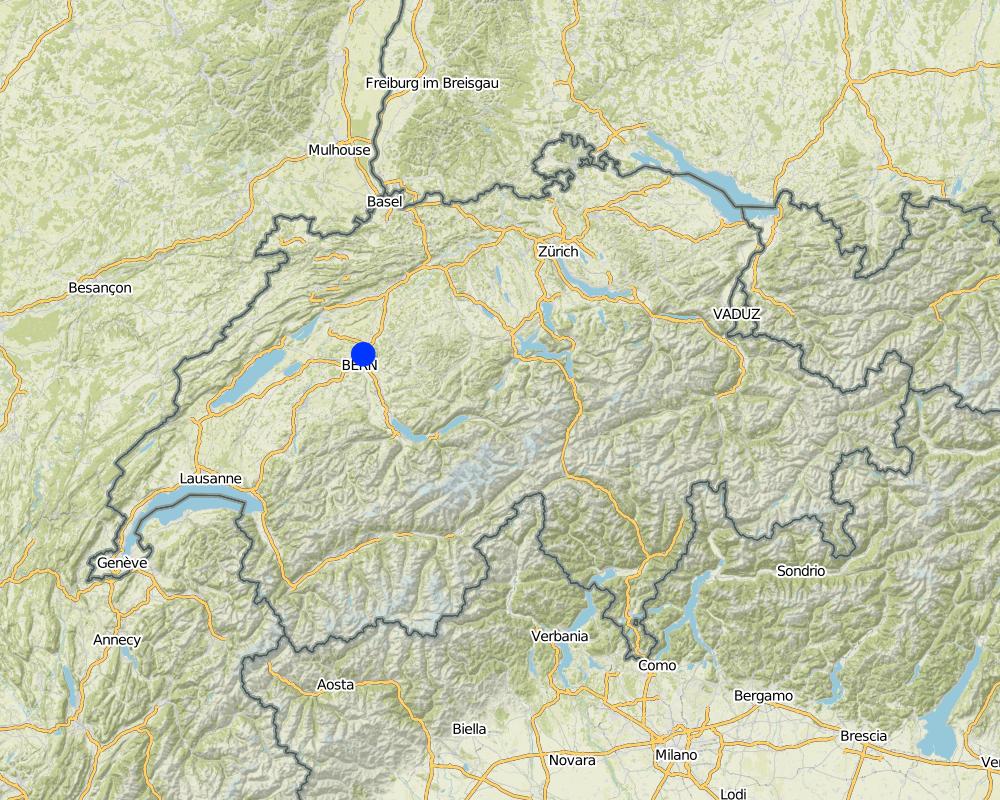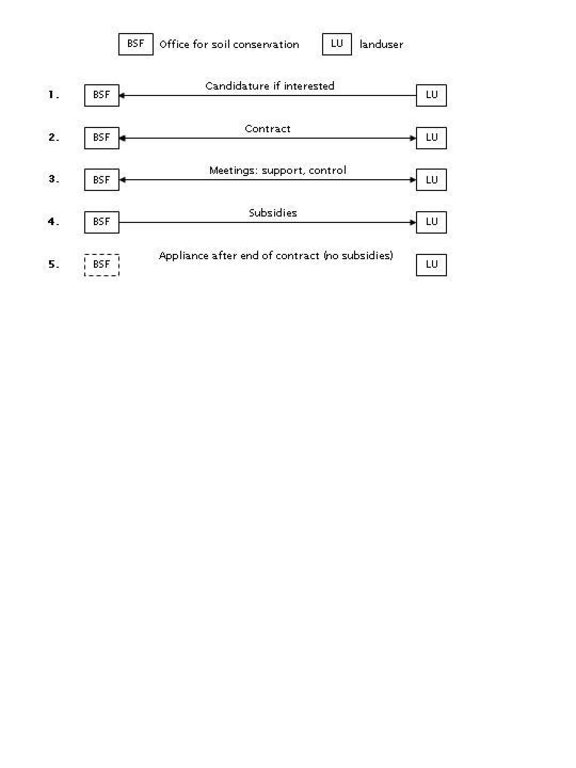Subsidies for conservation agriculture [สวิตเซอร์แลนด์]
- ผู้สร้างสรรค์:
- การอัพเดท:
- ผู้รวบรวม: Unknown User
- ผู้เรียบเรียง: –
- ผู้ตรวจสอบ: David Streiff
Umstellungsverträge
approaches_2632 - สวิตเซอร์แลนด์
ดูส่วนย่อย
ขยายทั้งหมด ย่อทั้งหมด1. ข้อมูลทั่วไป
1.2 รายละเอียดที่ติดต่อได้ของผู้รวบรวมและองค์กรที่เกี่ยวข้องในการประเมินและการจัดเตรียมทำเอกสารของแนวทาง
วิทยากรหลัก
ผู้เชี่ยวชาญ SLM:
Wyler Roman
สวิตเซอร์แลนด์
ผู้เชี่ยวชาญ SLM:
Hofer Peter
+41 (0)31 970 53 37
Peter.hofer@vol.be.ch
Amt für Landwirtschaft und Natur des Kantons Bern LANAT
Rütti, 3052 Zollikofen
สวิตเซอร์แลนด์
ชื่อของโครงการซึ่งอำนวยความสะดวกในการทำเอกสารหรือการประเมินแนวทาง (ถ้าเกี่ยวข้อง)
Amt für Landwirtschaft und Natur des Kantons Bern (LANAT) - สวิตเซอร์แลนด์1.3 เงื่อนไขที่เกี่ยวข้องกับการใช้ข้อมูลที่ได้บันทึกไว้ผ่านทาง WOCAT
ผู้รวบรวมและวิทยากรหลักยอมรับเงื่อนไขเกี่ยวกับการใช้ข้อมูลที่ถูกบันทึกผ่านทาง WOCAT:
ใช่
1.4 การอ้างอิงถึงแบบสอบถามเรื่องเทคโนโลยี SLM
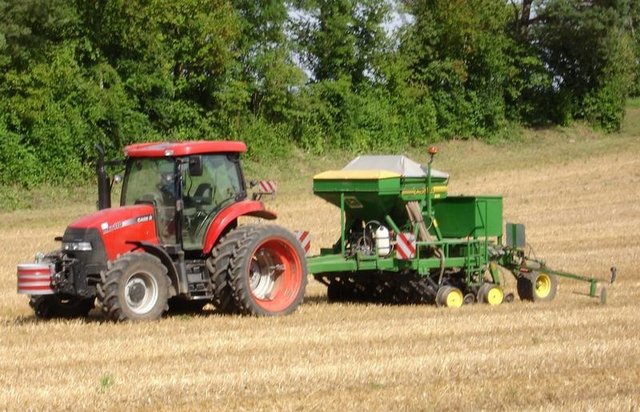
Direct seeding [สวิตเซอร์แลนด์]
A cropping system which allows to plant the seeds directly into the soil without ploughing. The soil is covered with plant remainders.
- ผู้รวบรวม: Unknown User
2. คำอธิบายของแนวทาง SLM
2.1 การอธิบายแบบสั้น ๆ ของแนวทาง
Land users commit to apply conservation agriculture on parts of their land for a period of 5 years. In return they get subsidies during this period.
2.2 การอธิบายอย่างละเอียดของแนวทาง
การอธิบายอย่างละเอียดของแนวทาง:
Aims / objectives: The Swiss environment protection law defines that soil fertility must be conserved on a long term basis. The cantons have to execute this national law. The way this is done differs from canton to canton. In this study the strategy of the canton of Berne is documented. It has three major goals: The prevention of soil erosion, the reduction of nitrate wash out and the prevention of soil compaction.
Methods: To reach these goals, farmers who accept to use conservation technologies can get additional subsidies for a period of 5 years. Furthermore they are supported by advisors. In this way land users are encouraged to change to soil conservation technologies, financial risk during the establishment phase is reduced due to the subsidies. The approach consist basically of a contract between land users and the office for soil conservation, in which land users commit to apply only soil conservation technologies on parts or on all their land during a period of 5 years. During that time direct seeding must be applied at least 2 times for main crops and for half of the catch crops. For the remaining crops ploughing is not allowed either. Technologies which reduce the reworking of the soil such as maize strip tillage ('Streifenfrässaat') or mulching need to be applied. In return land users get subsidies (during 5 years) which depend on the crop and the technology used. The highest subsidies are granted if direct seeding is used. The office for soil conservation is running a demonstration study comparing direct seeding to conventional agriculture. This helps land users to estimate the effects the new technology would have when applied in practice. If a specific farm receives the subsidies depends on whether in the running year there is still financial resources for the program. Resources have been limited by the government. Additionally it depends on where the farm is located. Farms that located in regions of major nitrate contamination, enhanced risk of eronsion or soil compaction or in regions with drinking water sources or polluted surface water are incorporated first. Land users can have their whole farm or single fields under contract. However a specific field can not be under contract for more than one period (5 years). As soon as a farmer gets a contract, details about which crop to plant where and when, with which technology are discussed by the farmer and an advisor.
Other important information: The goal is to find the best solution for every land user. Meetings of that kind take place on a regular basis. Besides supporting the farmer, advisors also check if conservation agriculture technologies are really being applied. After the 5 years under contract, it is the land users choice whether they want to continue using conservation technologies or not. Monitoring of the office for soil conservation shows that 85% keep on using conservation technologies. Its seems that the approach has a long term influence and subsidies are needed in the beginning only.
2.3 รูปภาพของแนวทาง
2.5 ประเทศ ภูมิภาค หรือสถานที่ตั้งที่ได้นำแนวทางไปใช้
ประเทศ:
สวิตเซอร์แลนด์
ภูมิภาค/รัฐ/จังหวัด: :
Canton of Berne
Map
×2.6 วันที่เริ่มต้นและสิ้นสุดของแนวทาง
ระบุปีที่เริ่ม:
1996
ความคิดเห็น:
It is possible to get subsidies in the whole canton of Berne. Cropland area in the canton is 539 km2, 2517 ha were under contract in the year 2006.
2.7 ประเภทของแนวทาง
- ใช้โครงงานหรือแผนงานเป็นฐาน
2.8 เป้าหมายหรือวัตถุประสงค์หลักของแนวทาง
The Approach focused on SLM only
Spreading of conservation agriculture in areas with an enhanced risk for soil erosion and or washing out of nutritients. Good quality support so that farmers will not have lower crop yield due to the technology and therefore continue using conservation agriculture after 5 years without external support.
The SLM Approach addressed the following problems: Water erosion under intense rainfall. Washing out of Nitrate to the ground water. Soil compaction.
2.9 เงื่อนไขที่เอื้ออำนวยหรือเป็นอุปสรรคต่อการนำเทคโนโลยีภายใต้แนวทางนี้ไปปฏิบัติใช้
บรรทัดฐานและค่านิยมทางสังคม วัฒนธรรม ศาสนา
- เป็นอุปสรรค
Ploughing is an important part of the tradition of agriculture. People are very critical towards no-tillage technologies, since they don't fit the common understanding of agriculture.
Treatment through the SLM Approach: The people working in the project are farmers themselves. They can give on their practical experience. Furthermore a demonstration study can be visited
การมีไว้ให้หรือการเข้าถึงแหล่งการเงินและบริการ
- เป็นอุปสรรค
Most farmers have achinery for conventional agriculture. To change to conservation agriculture major investments need to be done or contractors need to be tasked. Furthermore crop yield can be lowered in the beginning.
Treatment through the SLM Approach: When changing to conservation agriculture farmers are supported financially for a period of 5 years.With this money the risk in case of crop failure ond the costs for a contractor are lowered.farmers can test a new techniquewithout major expenses or risks
กรอบแนวทางในการดำเนินการด้านกฎหมาย (การถือครองที่ดิน สิทธิในการใช้ที่ดินและน้ำ)
- เป็นอุปสรรค
If the owner of the farm changes, the new owner often returns to conventional agriculture.
Treatment through the SLM Approach: No solution inside the project
The existing land ownership, land use rights / water rights hindered a little the approach implementation In Switzerland the number of farms is decreasing. New owners of land sometimes change back to conventional agriculture. It is possible however, that the new owner introduces conservation technologies.
อื่นๆ
- เป็นอุปสรรค
In Switzerland there are subsidies to support farmers in hilly terrain. This encourages farmers plant crops on steeper slopes and therefore enhances the risk of erosion. This is not a constraint for the technology however.
Treatment through the SLM Approach: Conservation agriculture helps to reduce erosion. However the project cannot change the fact, that these subsidies enhance the risk of erosion.
3. การมีส่วนร่วมและบทบาทของผู้มีส่วนได้ส่วนเสียที่เกี่ยวข้อง
3.1 ผู้มีส่วนได้ส่วนเสียที่เกี่ยวข้องในแนวทางนี้และบทบาท
- ผู้ใช้ที่ดินระดับท้องถิ่นหรือชุมชนระดับท้องถิ่น
Contracts are signed by the office for soil conservation and the head of the farm, who in general is male. The decision about which technology is applied is usually taken at the household level including both women and men.
- ผู้เชี่ยวชาญ SLM หรือที่ปรึกษาการเกษตร
- รัฐบาลแห่งชาติ (ผู้วางแผน ผู้ทำการตัดสินใจ)
The national government tasked the cantons with soil conservation. Therefore approaches differ from canton to canton.
3.2 การเกี่ยวข้องของผู้ใช้ที่ดินระดับท้องถิ่นหรือชุมชนระดับท้องถิ่นในช่วงต่างๆของแนวทาง
| ความเกี่ยวข้องของผู้ใช้ที่ดินระดับท้องถิ่นหรือชุมชนระดับท้องถิ่น | ระบุผู้ที่มีส่วนเกี่ยวข้องและอธิบายกิจกรรม | |
|---|---|---|
| การริเริ่มหรือการจูงใจ | ไม่มี | The project was introduced through the office for soil conservation |
| การวางแผน | ปฏิสัมพันธ์ | Landusers who wish to get subsidies have contact the office for soil conservation. It is the land users decision on which of their fields they want apply the technology. |
| การดำเนินการ | จ่ายเงินหรือสนับสนุนจากภายนอก | Land user get subsidies for a period of 5 years, during which they have to apply soil conservation technologies. To actually use the technology they task a contractor or do the work on their own. |
| การติดตามตรวจสอบหรือการประเมินผล | ปฏิสัมพันธ์ | As there are discussions with the advisor on a regular basis, the implementation of the technology is monitored both by the farmer and the advisor. |
| Research | ไม่มี | There is a demonstration study where direct seeding and conventional agriculture is compared. |
3.3 แผนผังแสดงขั้นตอนการทำงาน (ถ้ามี)
คำอธิบาย:
Interactions between the office for soil conservation and land users during the progression of the project.
ผู้เขียน:
Roman Wyler
3.4 การตัดสินใจเลือกใช้เทคโนโลยี SLM
ระบุผู้ที่ทำการตัดสินใจเลือกเทคโนโลยีมากกว่าหนึ่งวิธีไปปฏิบัติใช้:
- ผู้เชี่ยวชาญ SLM เป็นผู้ตัดสินใจหลัก ที่ติดตามให้คำปรึกษากับผู้ใช้ที่ดิน
การอธิบาย:
The decisions were taken by the office for soil conservation. Since these people are working as farmers, too, land users perspective could be included.
Decisions on the method of implementing the SLM Technology were made by mainly by land users supported by SLM specialists. To get the subsidies criteria from the contract need to be accepted. Besides this, land users can decide on their own how land is cultivated.
4. การสนับสนุนด้านเทคนิค การสร้างขีดความสามารถ และการจัดการด้านความรู้
4.1 การสร้างขีดความสามารถ / การอบรม
ได้มีการจัดอบรมให้แก่ผู้ใช้ที่ดินหรือผู้มีส่วนได้ส่วนเสียคนอื่น ๆ หรือไม่:
ไม่ใช่
4.2 การบริการให้คำแนะนำ
ผู้ใช้ที่ดินมีการเข้าถึงการรับบริการให้คำปรึกษาหรือไม่:
ใช่
ระบุว่ามีบริการให้คำปรึกษาหรือไม่:
- ไปเยี่ยมชมสถานที่
การอธิบาย/แสดงความคิดเห็น:
nnual meetings between land user and advisor; Key elements: Technical support, Planning of crop rotation and technologies applied, Monitoring
Advisory service is quite adequate to ensure the continuation of land conservation activities; Following a study of the office for soil conservation most land users continue to use conservation technologies after the end of the contract.
4.3 การเสริมความแข็งแกร่งให้กับสถาบัน (การพัฒนาองค์กร)
สถาบันได้รับการจัดตั้งขึ้นมาหรือเสริมความแข็งแกร่งโดยแนวทางนี้หรือไม่:
- ใช่ เล็กน้อย
ระบุระดับของสถาบันที่ได้รับการเสริมความแข็งแกร่งหรือจัดตั้งขึ้นมา:
- ท้องถิ่น
ให้รายละเอียดเพิ่มเติม :
The office for soil conservation was involved in Swiss no-till, which is a platform to exchange knowledge.
4.4 การติดตามตรวจสอบและประเมินผล
การติดตามตรวจสอบและประเมินผลเป็นส่วนหนึ่งของแนวทางหรือไม่:
ใช่
ความคิดเห็น:
bio-physical aspects were regular monitored by 0 through observations; indicators: advisory meetings
technical aspects were regular monitored by 0 through observations; indicators: advisory meetings
economic / production aspects were None monitored by 0 through measurements; indicators: farmer himself
area treated aspects were None monitored by government through measurements; indicators: only the area under contract is known
no. of land users involved aspects were None monitored by 0 through None; indicators: only the number of land users under contract is known
survey aspects were None monitored by land users through None; indicators: afther the first two years there was an evalution of the project. Farmers were asked for their opini
4.5 การวิจัย
การวิจัยเป็นส่วนหนึ่งของแนวทางหรือไม่:
ใช่
ระบุหัวข้อเรื่อง:
- เทคโนโลยี
ให้ข้อมูลเพิ่มเติมและให้ระบุผู้ทำการวิจัย:
Research is not part of the actual project. However the advisors are involved in research projects through other activities. Therefore new knowledge is usually incorporated in the advisory meetings.
Research was carried out both on station and on-farm
5. การสนับสนุนด้านการเงินและวัสดุอุปกรณ์
5.1 ระบุงบประมาณประจำปีสำหรับแนวทาง SLM นี้
ถ้าหากว่างบประมาณประจำปีไม่เป็นที่ทราบแน่นอน ให้ระบุช่วงลงไป:
- 10,000-100,000
แสดงความคิดเห็น (แหล่งของการระดมทุน ผู้บริจาคคนสำคัญ):
Approach costs were met by the following donors: government (Kanton Bern): 100.0%
5.2 การสนับสนุนด้านการเงิน / วัสดุอุปกรณ์ให้แก่ผู้ใช้ที่ดิน
ผู้ใช้ที่ดินได้รับการสนับสนุนด้านการเงิน / วัสดุอุปกรณ์ไปปฏิบัติใช้เทคโนโลยีหรือไม่:
ใช่
ถ้าใช่ ให้ระบุประเภทของการสนับสนุน เงื่อนไขและผู้จัดหามาให้:
Canton of Berne
5.3 เงินสนับสนุนสำหรับปัจจัยนำเข้า (รวมถึงแรงงาน)
- การเกษตร
| ระบุปัจจัยนำเข้าที่ได้รับการสนับสนุน | เห็นด้วยระดับไหน | ระบุเงินสนับสนุน |
|---|---|---|
| เมล็ด | ได้รับการช่วยเหลือทางการเงินบางส่วน | |
| ปุ๋ย | ได้รับการช่วยเหลือทางการเงินบางส่วน | |
ความคิดเห็น:
There are subsidies per field under contract for a period of 5 years. During that time direct seeding must be applied at least 2 times for main crops and for half of the catch crops. For the remaining crops ploughing is not allowed either.
5.4 เครดิต
มีการจัดหาเครดิตมาให้ภายใต้แนวทาง SLM หรือไม่:
ไม่ใช่
6. การวิเคราะห์ผลกระทบและการสรุป
6.1 ผลกระทบของแนวทาง
ช่วยให้ผู้ใช้ที่ดินนำเอาเทคโนโลยี SLMไปใช้และบำรุงรักษาสภาพไว้ได้หรือไม่:
- ไม่ใช่
- ใช่ เล็กน้อย
- ใช่ ปานกลาง
- ใช่ อย่างมาก
the advisory meetings help land users to better understand soil processes.
ทำให้กลุ่มด้อยโอกาสมีอำนาจทางสังคมและเศรษฐกิจหรือไม่:
- ไม่ใช่
- ใช่ เล็กน้อย
- ใช่ ปานกลาง
- ใช่ อย่างมาก
Did other land users / projects adopt the Approach?
- ไม่ใช่
- ใช่ เล็กน้อย
- ใช่ ปานกลาง
- ใช่ อย่างมาก
Other cantons in Switzerland have started to subsidise conservation agriculture too.
Did the Approach lead to improved livelihoods / human well-being?
- ไม่ใช่
- ใช่ เล็กน้อย
- ใช่ ปานกลาง
- ใช่ อย่างมาก
income is slightly enhanced in most cases.
Did the Approach help to alleviate poverty?
- ไม่ใช่
- ใช่ เล็กน้อย
- ใช่ ปานกลาง
- ใช่ อย่างมาก
6.2 แรงจูงใจหลักของผู้ใช้ที่ดินเพื่อที่จะนำ SLM ไปปฏิบัติใช้
- กำไร (ความสามารถ) อัตราส่วนค่าใช้จ่ายต่อผลประโยชน์ที่เพิ่มขึ้น
- การจ่ายเงินหรือการช่วยเหลือ
- จิตสำนึกด้านสิ่งแวดล้อม
prevention of erosion
6.3 ความยั่งยืนของกิจกรรมของแนวทาง
ผู้ใช้ที่ดินสามารถทำให้สิ่งต่างๆ ที่ได้ปฏิบัติใช้โดยแนวทางนี้ยั่งยืนได้หรือไม่ (โดยไม่มีการสนับสนุนจากภายนอก):
- ใช่
ถ้าตอบว่าใช่ ให้อธิบายว่าอย่างไร :
on a long term perspective conservation agriculture is rather cheaper. Only in the beginning it costs more.
6.4 จุดแข็งและข้อได้เปรียบของแนวทาง
| จุดแข็ง / ข้อได้เปรียบของแนวทางในทัศนคติของผู้ใช้ที่ดิน |
|---|
| Not land user, but advisor of the project! |
| The structure of the project enables individual solutions. Still there are incentives for conservation agriculture. (How to sustain/ enhance this strength: Working together with the land users, searching for the best individual solution.) |
| After the end of the contract, there are no costs anymore. (How to sustain/ enhance this strength: armers should be supported as good as possible, so that they are familiar with the technology and continue to apply it after the end of the contract.) |
| Advisors involved in the project all have an agricultural background, they are therefore familiar with the problems of farmers. (How to sustain/ enhance this strength: Working together with the farmers and trying adjust the program to their needs.) |
6.5 จุดอ่อน / ข้อเสียเปรียบของแนวทางและวิธีในการแก้ไข
| จุดอ่อน / ข้อเสียเปรียบในทัศนคติของผู้ใช้ที่ดิน | สามารถแก้ไขปัญหาได้อย่างไร |
|---|---|
| Compared to the total number of farms the number of participants is rather small. | conditions for participation could be reduced in order to reach more people. This would however increase the costs. |
| จุดอ่อน / ข้อเสียเปรียบในทัศนคติของผู้รวบรวมหรือวิทยากรหลัก | สามารถแก้ไขปัญหาได้อย่างไร |
|---|---|
| Subsidies are expensive for the state. Since resources are limited there is already a waiting list for the farmers. | soil consvervation should get a higher importance in politics. This is not the case because most people don't even know that soil degradation is a problem. |
| f there is no possibility to rent the machines in the region, costs are very high, even if there are subsidies. | here it could be a possiblity to support contractors to buy the machines needed, so that land users could apply the technology at lower costs. |
7. การอ้างอิงและการเชื่อมต่อ
7.1 วิธีการหรือแหล่งข้อมูล
- ไปเยี่ยมชมภาคสนาม การสำรวจพื้นที่ภาคสนาม
- การสัมภาษณ์ผู้เชี่ยวชาญด้าน SLM หรือผู้ชำนาญ
7.2 การอ้างอิงถึงสิ่งตีพิมพ์
ชื่อเรื่อง ผู้เขียน ปี ISBN:
Amt für Landwirtschaft und Natur des Kantons Bern LANAT, Rütti, 3052 Zollikofen. Kanton Bern fördert Ressourcen schonenden Ackerbau.AGRARForschung 14 (3): 128-133, 2007.
ช่องทางในการสืบค้น และราคา:
http://www.vol.be.ch/site/lanat-3155-mbressourcen.pdf
ลิงก์และโมดูล
ขยายทั้งหมด ย่อทั้งหมดลิงก์

Direct seeding [สวิตเซอร์แลนด์]
A cropping system which allows to plant the seeds directly into the soil without ploughing. The soil is covered with plant remainders.
- ผู้รวบรวม: Unknown User
โมดูล
ไม่มีโมดูล


